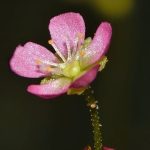
TREE LIFE 540
AUGUST 2025
PLANNED EVENTS:- AUGUST
Since inclement weather or other issues may vary our plans, WhatsApp Tony Alegria on 0772 438 697 to join our WhatsApp group for last minute updates.
Saturday 2nd August 2025:- visit to the National Botanic Gardens. Meet at 8.30 in the main car park and join us for a morning looking at trees that catch our interest.
Sunday 17th August 2025:- Main outing to Rob Kelly’s property on Borrowdale Rd
Directions: Will be circulated to members via the WhatsApp group. Non-members to contact Tony Alegria for directions.
You do not have to be a member to join us for the day. You may decide to become a member and join us for many more activities.
CHALLENGE: One of the objectives of the Tree Society is “To create an Awareness amongst the public, of the importance of trees.” There is a page on our website entitled the importance of trees: https://treesociety.org.zw/importance-of-trees/. The challenge is to go to this page and to read it through, let me know if you agree or disagree with the text. Also make suggestions as to how we can create more awareness in any way possible.
A QUICK UPDATE
We hear via Mark Hyde that the re invented “Barefoot botanist” Dr. David Gwynne-Evans and his partner in crime Shereen Young, who spent an afternoon with us at the end of May (See the June edition of Tree Life), have now, after many adventures in Mozambique and Malawi, reached Tanzania and are about to ascend Kilimanjaro.
NOTE: For the purposes of our newsletter, all species of acacia have been given their specific genus name, Vachellia or Senegalia.
REPORTS FROM PREVIOUS OUTINGS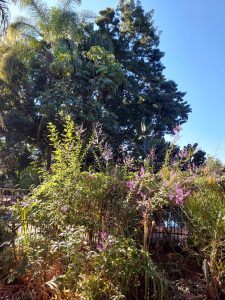
Main outing Saturday 28th June 2025
By Tony Alegria, photo by Peter Morris
On a sunny afternoon when it was hot in the sun and cold in the shade, we had a good tree outing attendance at the home of Peter and Frances Morris, which is also the home of Mary Lovemore who occupies the cottage. Apart from the residents (Frances, Mary & Peter) we had many ladies present: Ann Butler, Ann Sinclair, Barbara Maasdorp, Dawn Siemers, Jenny Whitaker, Soo Fawcett, Teig Howson and Wendelin Zwanikken. But not too many men: Adrian Maasdorp, Jim Dryburgh, Mark Hyde and Tony Alegria.
Peter and Francis have a very impressive list (some of which were handed out) of most of the trees and bushes on their property – a hundred plus! They have also recently planted a few more trees – where an Acacia xanthophloea, which grows so big, is going to find space in that garden is a mystery!
We began by looking outside the gate but still within the property and saw:
- A Tabernaemontana elegans. Toad tree which had flowered but was too young to have fruited.
- The biggest Carissa bispinosa. Y-thorned numnum I have ever seen with vicious looking “Y – shaped” thorns.
- A small Celtis africana. White-stinkwood
- A large Persea americana, an avocado pear tree also known as the alligator pear. The avocado pear tree is native to the Americas – southern part of North America and northern part of South America and in between.
Next to the gate near some carports is a 20 year something old huge Cordia africana. Other big trees in the garden included: Acacia abyssinica, Fernandoa abbreviata, Trichilia dregeana, Croton megalocarpus, Melaleuca sp. and a Podocarpus falcatus. And growing to the very top of some of these trees was the Zimbabwe creeper, Podranea brycei with its showy flowers.
Not doing so well was a camphor tree, Cinnamomum camphora which has been shaded out by the yellow-wood, while nearby was a pretty big Hamelia patens – common names include firebush, hummingbird bush, scarlet bush, and redhead. This large bush is native to the American subtropics and tropics. Sunbirds love it!
There is an Australian tree which looks like one of the Brachychitons. Brachychitons are rather strange trees in that they have gi-normous boles compared to their height – there are many of them (street trees) within Harare. Their fruit resemble that of the Sterculias.
Growing next to the veranda is a wide spreading, not too tall, Millettia pinnata whose identity mystified the experts for a long time. This tree was planted from seed brought in from Maputo by Mary’s late husband. I found this in Wikipedia: Pongamia pinnata is a species of tree in the pea family, Fabaceae, native to eastern and tropical Asia, Australia, and the Pacific islands. It is the sole species in genus Pongamia. It is often known by the synonym Millettia pinnata. Its common names include Indian beech tree, Karanja, and Pongame oiltree.
Of course we saw many other trees in the garden, far too numerous to list here. It was a good afternoon and was rounded off with a slap-up tea to finish! Very many thanks to Peter, Frances and Mary for opening their home to us.
Saturday 5th July 2025:- National Botanic Garden Outing
By Mark Hyde, photos by Jim Dryburgh
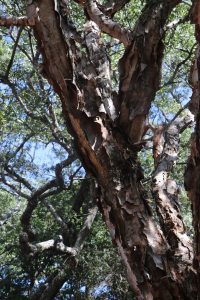
Vachellia sieberiana; the paperbark acacia
When I was appointed to lead this month’s walk, I cast around for something different and decided we would discuss bark. I don’t tend to look at it very much and it was indeed interesting to focus on it.
There were only five of us: Dido de Swardt, Busi Malunga, Jim Dryburgh, Charles Crawshaw and me.
Why do trees have bark? Essentially it is about protection – from fire, from physical damage, from the weather (wind and rain, high and low temperatures, sunlight), from attacks by pests (borers, termites, diseases), and fungi and in order to retain water.
Bark may also be porous, allowing the tree to breathe. It may also contain chlorophyll thus permitting photosynthesis.
Rough-barked trees easily acquire a layer of other organisms, such as small insects lichens, epiphytic plants and fungi. A defence against this is to have bark that peels off. This was illustrated by the well-known Paperbark acacia (Vachellia sieberiana) in the Botanic Garden carpark which has exceptionally thick and well-developed peeling bark. Nothing is likely to remain attached to that trunk for long.
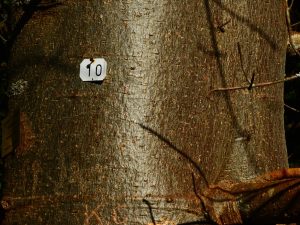
Smooth bark of the baobab
An alternative strategy to ensure a ‘clean’ trunk is to have totally smooth bark to which nothing can adhere. An example of that is the baobab tree.
Many rough barked trees are vertically fissured, perhaps a consequence of the bark splitting as the trunk expands with age. Sometimes these fissures are neatly parallel (Vitex payos springs to mind) but more often the ridges weave in out fusing with each other and separating, a feature known as anastomosing.
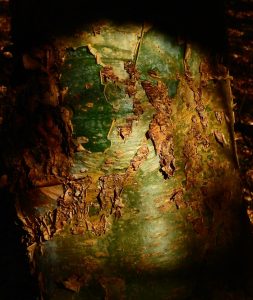
Green bark of
Commiphora marlothii
Bark may be taxonomically useful. The genus Commiphora is a good example of that with each species often having a distinctive bark which is particularly helpful as so often the trees are leafless. Some species have coloured barks (green in C. marlothii, blue in C. caerulea and black-and-white-striped in C. viminea).
Eucalyptus is another genus where the bark may be helpful. We looked at Eucalyptus (Corymbia) torelliana; the lower part was rough and grey, the upper part smooth and green. Other species have thick, rough bark; others often smooth with no dark bark.
Bark cannot always be relied on though; it can be damaged in all sorts of ways and become atypical.
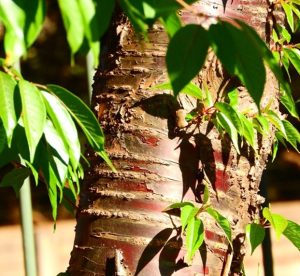
Transversely ringed bark of Prunus cerasoides
In contrast to the longitudinally fissured barks, some trees have transversely arranged features. One we examined was Prunus cerasoides (Himalayan flowering cherry).
A general feature of the trees in the Botanic Garden was a general redness of the bark, perhaps caused by the red soils of the Garden. Also, many trees had one type of bark in their lower parts (the first few meters) and a different type of bark further up. Perhaps this was just a question of age.
Other trees with distinctive barks are (a) trees with peeling pieces of bark giving a patchy trunk (Stereospermum kunthianum, the Pink jacaranda) and (b) trees bearing knobs, these sometimes with terminal thorns (Senegalia nigrescens, the Knobthorn).
This was a good subject which created a lot of discussion among those attending.
Main outing Sunday 20th July 2025 a visit to Christon Bank
The report on this outing will be included with next month’s Tree Life.
FROM THE WALRUS TO THE CARPENTER
THE MIGHTY TAMARIND TREES
By Richard Whitaker
 I love tamarind trees, Tamarindus indica. In my opinion they are one of the “Three Kings of the Valley” together with baobabs and albidas. These three icons are sacred in ancient African culture and this does not surprise me at all.
I love tamarind trees, Tamarindus indica. In my opinion they are one of the “Three Kings of the Valley” together with baobabs and albidas. These three icons are sacred in ancient African culture and this does not surprise me at all.
They are certainly a controversial tree. It amuses me that there is heated debate about their origins. Some say that they are native to Africa and were introduced from here to India, others that they originated in India and are native to that country – hence the ‘indica’.
The name ‘tamarind’ is said to be from the Arabic word “Tamar-i-Hind” which is an Arabic term meaning “Indian date,” and it refers to the tamarind fruit (see Tree Life of September 2008 – issue 340.) I have a simple solution to the debate; I think that the tamarind trees are native to both India and Africa. The detail of their distribution is not the only thing that is controversial about the tamarind as you will see later on in this article.
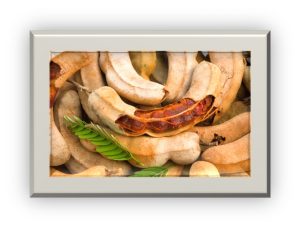 The fruits of this beautiful tree are delicious and there is nothing better than to rest in the shade of these trees on a hot, blistering day in the Zambezi Valley and suck on the tangy seeds and pulp of the pods. Musika, as it is locally known, is used by communities for food, drink, and traditional medicine while the fruit pulp is widely used in traditional dishes, beverages like sobolo and sauces where it adds a delicious tangy flavour to meals.
The fruits of this beautiful tree are delicious and there is nothing better than to rest in the shade of these trees on a hot, blistering day in the Zambezi Valley and suck on the tangy seeds and pulp of the pods. Musika, as it is locally known, is used by communities for food, drink, and traditional medicine while the fruit pulp is widely used in traditional dishes, beverages like sobolo and sauces where it adds a delicious tangy flavour to meals.
The leaves, seeds and flowers are also consumed in various local preparations across West Africa and traditional healers use tamarind for treating ailments such as fever, digestive issues, and even meningitis.
In African folklore, tamarind is seen as a symbol of patience, resilience and healing. Its tough pods and slow growth reflect endurance through hardship, and its ability to thrive in dry climates and poor soils reinforces its image as a survivor. In some communities, tamarind trees are considered sacred and are protected by taboos and rituals. They are featured in communal meals and rituals, symbolising unity. The tree often symbolizes ancestral heritage, with ceremonies held when ancient tamarind trees die.
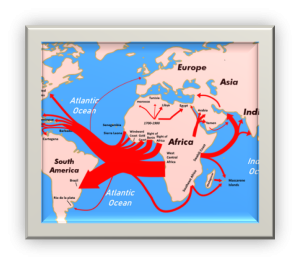 The biggest of all controversies:
The biggest of all controversies:
Is the distribution of the tamarind
- due to nature
- due to slave traders who purposely planted tamarind trees along their slave routes so that they could dose up the slaves on vitamin C and thereby increase the chances of them surviving the arduous journeys to the slave ports as well as the a trans-Atlantic journey where scurvy was a killer
- or is the distribution due to some other factor.
In my opinion, if a theory is true, then there must be no evidence to the contrary.
I note that:
- Tamarindus indica is native to tropical Africa and was already widespread in many regions before the slave trade intensified. Its presence along trade routes may reflect natural growth patterns or indigenous cultivation, not deliberate planting by slave traders.
- Slave routes often followed rivers, savannas, and established caravan paths — the areas where tamarind trees naturally thrive. The trees may also have been landmarks or resting points, not necessarily planted with a medicinal agenda.
- Many slaves may have reached the slave ports before they became a written record and there is no documented proof in ship logs, trade records, or plantation journals that slave traders systematically planted tamarind trees for health reasons.
- The concept of vitamin C deficiency wasn’t well understood until the 18th century, and even then, citrus fruits like lemons and limes were more commonly used by European sailors.
- Most records from the transatlantic and Indian Ocean slave trades focus on logistics, cargo, and profits — not on the welfare of enslaved people. What a contradiction! The welfare of the slaves was obviously going to affect profits.
So, were tamarind trees planted deliberately?
The last point is the reason why I now start believing the theory that tamarind trees were planted deliberately. In addition, the anecdotal evidence that makes me believe that traders (especially Arab traders) did plant tamarind trees on purpose.
- When I was working as a Professional Guide, I took a group of tourists on a five-night back-packing trip on top of the Matusadona mountains. We camped one night near a spring and there was a tamarind tree growing there. The National Parks guys at Sanyati West Camp told me that oral history said that the tree was planted by Arabs.
- In Mana Pools, the tamarind trees are not growing along the banks of the Zambezi – they are growing where the banks of the Zambezi used to be in the days of the trade. For example, you will find them along the south bank of Long Pool but not along the North bank. Needless to say, the north bank of Long Pool was under water in those days.
- Kanyemba Island, which used to be a major transit point for slaves during the days of the trade is surrounded with tamarind trees. That is why the tented camp found there was named Tamarind Tented Camp.
- When I was working in Zambia, I was told by a reputable source that the tamarinds growing along the Muleya River were, according to oral history, planted by Arab traders. The Muleya joins the Kafue River which also joins the Zambezi.
Call me a fool, but I am a believer in the theory that tamarinds were purposely planted by Arab slave traders. Why wouldn’t they have done so?!
The tamarind in the new world
Tamarind is present in the cuisines of Mexico and the Caribbean. It has a very strong diasporic identity amongst the African-descended communities. Tamarind drinks, koola nut rituals and okra stews are still central to Afro-diasporic cultures in the Caribbean, Brazil and American South. You can see this in dishes like gumbo, bissap and callaloo.
The joke is that it was probably the slaves who were responsible for bringing seeds hidden in their hair when they made the journey.
Tamarind and other plants became part of enslaved Africans’ botanical legacy through a powerful blend of survival, memory, and cultural resilience. This legacy unfolded across the Atlantic world in ways that were both intentional and deeply rooted in ancestral knowledge.
A call to readers of Tree Life; do you have memories of a verbal history relating to the slave trade and or the introduction of plants to Zimbabwe for other reasons?
Labelling Trees – Part 1
By Tony Alegria
Mukuvisi Woodlands
When I joined the Mukuvisi Woodlands Council many years ago, I suggested that because Mukuvisi was a public walking area, the trees should be labelled.
Predictably the Chairman said “Good idea, can you do it?”
My knowledge of trees was very limited at that time, I knew what a Jacaranda tree was as well as Mango and Guava. I also knew there were many species of gum trees and a Msasa or was it a Munondo? I wanted to learn about trees so I agreed to do it!
The Interpretive Centre in Mukuvisi has many trees, some indigenous and some exotic, and had been labelled at least twice before. However, the labels (I saw evidence of one type of labelling) disappeared. Why anyone would want to steal a label, which consisted of the tree name on a piece of cardboard enclosed in a bit of plastic, boggles the mind!
However, if that’s what happens then a thief proof system had to be implemented! I found that system whilst on a birding trip to the Eastern Highlands down Chipinge way. Whilst in Chirinda Forest, I noticed numbers painted on trees. These numbers are used in the book: Chirinda Forest – A Visitors’ Guide. Well, this was it! A number painted on a tree cannot be stolen. However, there were issues with this as I found out later on.
Fortunately, Danny, a member of staff, had planted many of the Mukuvisi trees and knew most of them. He would tell me the identity of a tree and I would put up a temporary number on the tree until the number could be painted on.
The temporary numbers consisted of numbers engraved on rectangular bits of plastic that I had used previously in fishing circles. During a fishing competition, you moved the label from “IN” to “OUT” on the attendance board when you went fishing and when you returned, you then moved the number from “OUT” to “IN”. This meant that you had come back and were around somewhere or gone home if you had had a bad day or had urgent business to attend to. If you didn’t book yourself “IN” people would then come looking for you. This system is no longer needed as you can just use cell phones!
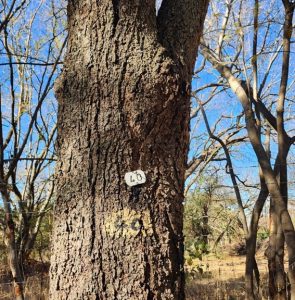 As soon as the numbers began to be painted, I received a call from the Chairman, in not so polite terms he wanted to know what the hell I was doing! Well, I went down to Mukuvisi to see what the issue was and there was an issue! The workers had painted huge numbers on the trees! After talking to the staff for a lengthy period, I finally found out why the numbers were so big, turns out they only had a four-inch paint brush! This issue was soon resolved and numbers consisting of a white background with the numbers painted in black soon appeared.
As soon as the numbers began to be painted, I received a call from the Chairman, in not so polite terms he wanted to know what the hell I was doing! Well, I went down to Mukuvisi to see what the issue was and there was an issue! The workers had painted huge numbers on the trees! After talking to the staff for a lengthy period, I finally found out why the numbers were so big, turns out they only had a four-inch paint brush! This issue was soon resolved and numbers consisting of a white background with the numbers painted in black soon appeared.
A tree list was put together with the number and the tree it represented. But, there was a problem, there were many trees that couldn’t be identified although most of the Shona names were known. This is when I found out from Barbara Britten, the Mukuvisi secretary at that point in time, that there was a Tree Society who most likely could help. I managed to find a contact for that organisation and two people turned up – Mark Hyde and Meg Coates Palgrave; and they were willing to help which really amazed me! So, many more trees were added to the list but there were still a few unknown trees. I found more names of people who knew trees resulting in the late Malcolm Leppard and Dave Hartung coming along and doing their bit, especially with exotic trees.
Now all was well with many of the trees having had numbers painted on them. However, there were many Msasa trees and only a few had numbers – no point in painting a number on every Msasa tree! Any other species that had many or a few trees on site just had one or two trees numbered.
Question one: If you wanted to see a particular tree, how did you know it was there?
Answer one: Have an index attached to the tree list with all the botanical tree names as well as common English and Shona names – also to include synonyms and old tree names.
Question two: If the tree was there, how do did find it?
Answer two: Sub-divide the Interpretive Centre into many areas using man-made structures – roads, buildings and fences and have a map to show the areas which were identified as A, B, C …etc. Then in the tree list have a location for each tree. For example, if the location is marked BF, then there are two trees with numbers, one in area B and the other in area F.
The pamphlet consisted of a tree list with the locations of the trees, Botanical name, most common English name, most common Shona name and where the tree was native to. There was the index as indicated above and also a list of most of the indigenous trees with their uses e.g. medicinal and what part of tree was used.
However, after a while, strange things began to happen to the painted numbers! The numbers on the Guava tree and the unknown gum tree came off with the peeling bark. The number on the Acacia xanthophloea gradually faded away. And the numbers on some of the maturing trees began cracking as the bark became rougher with age. Maintenance consisted of repainting the numbers on the trees, but it soon became obvious that some other solution was necessary.
READ NEXT MONTH’S ARTICLE FOR THE UPDATED SOLUTIONS.
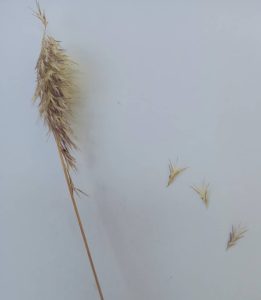
Harpachne schimperi
More Seeds in my Socks
By Mark Hyde, photos by Bill Clarke
Bill Clarke responded to my article in last month’s Tree Life with two additional species whose seeds end up in socks; these both from Val D’Or.
Harpachne schimperi
This is a grass, first recorded for Zimbabwe in 1990 and, unusually, is an inter-African introduction from NE and E Africa. Its inflorescence is somewhat bottle-brush like and as with most grasses the base of the spikelet (callus) is sharp and can readily penetrate socks.
A full history of its occurrence is given on the Zimbabwe flora website.
https://www.zimbabweflora.co.zw/speciesdata/species.php?species_id=105330.

Pseudarthria hookeri
Pseudarthria hookeri – the Velcro bush
This leguminous shrub is well known on our walks locally. Its pods are similar to those of Desmodium in that they split transversely, and each individual “article” can adhere to clothing.
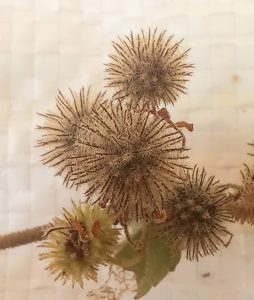
Triumfetta sp
Triumfetta sp.
Species of Triumfetta were mentioned in my first article, but Bill has now supplied us with a close-up of the fruits of one of the species which he found at Val D’Or.
……. I suspect there are more grass species still to be reported. Please do examine your socks to see what you pick up and I will further update these articles with anything new.
 ANOTHER UPDATE: POCKET FORESTS IN THE CITY OF BULAWAYO
ANOTHER UPDATE: POCKET FORESTS IN THE CITY OF BULAWAYO
by Linda Hyde
On 16th April, The City of Bulawayo launched its first “Indigenous Trees Pocket Forest” in Centenary Park (see the May issue of Tree Life). On 26th July we were in Bulawayo with Phoenix choir who arranged sightseeing to the Natural History Museum which stands in the grounds of Centenary Park. I therefore contacted Jenny and Busi and found out exactly where the forest was and Mark and I paid a visit. I am delighted to report that with monthly care and attention the trees are thriving, and Mark was unable to complain about the lack of labels (something he always notes), and in fact he was delighted with the clear and accurate labelling.
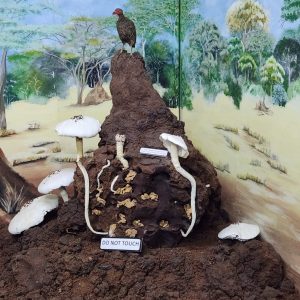
Thank you to Jennifer Coltart and the staff of the Park grounds for this opportunity to see what can be done to keep our green spaces. Do pay them a visit if you are in Bulawayo and take some time to see the new Fungus exhibit from Cathy Sharp in the museum.
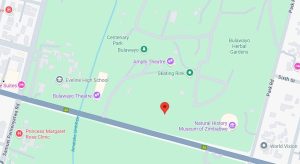
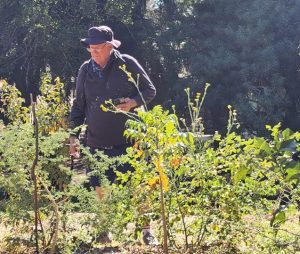
FROM THE CARPENTER
Munch’s Great Chimanimani Aloe
By Linda Hyde
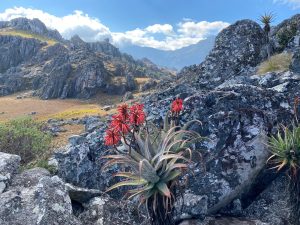
Aloe munchii: photo by Ken Flower 16th July 2025
My thanks to Doug Van der Ruit who posted this picture of Aloe munchii taken by Ken Flower who was with Tempe in the Chimanimani mountains this winter.
Aloe munchii, one of the Chimanimani endemics, is a large succulent shrub-like plant, single-stemmed or branching near the base and can reach 2 to 5 m tall. The leaves are about 50 cm long, greyish-green, without spots but often tinged pinkish-red, particularly along the toothed margins and form a dense rosette at the apices of the branches. This specimen is diseased, hence the spots. The flowers are bright orange-red, 35-45 mm long.
It has been suggested that it may be an adapted form of Aloe excelsa although growing in the quartzite grasslands on the mountain slopes, among large boulders where it is somewhat protected from fires, the flowering habit looks very different.
The aloe was named after Raymond Charles Munch (1901 – 1985), Zimbabwean farmer and plant collector with a particular interest in aloes and cycads. He arrived in Zimbabwe from South Africa in 1909 to join his father on Mona Farm in the Rusape district. A pupil at Prince Edward School in Harare, he soon developed an interest in trees and on leaving school he embarked on a career in the Government Forestry Department before changing this to continue farming on Mona Farm.

R C Munch
In the 1930’s he met up with Basil Christian and visited Ewanrigg and was encouraged to search for new aloe species. He found several unrecorded or described aloe species as well as Aloe munchii. He was also interested in cycads and had Encephalartos munchii named after him “in recognition for his perseverance over the years in encouraging and assisting botanists in unravelling the taxonomic problems connected to E manikensis and its closest allies.”
Under Raymond’s enthusiasm and botanical skills he and his wife Hazel constructed their first rockery and the garden flourished and grew until in 1973 Mike Kimberley described the garden at Mona as “extensive containing comprehensive collections of aloes, cycads, palms, indigeneous trees and cacti”.
Any updated information by members would add to the heritage that is our wild flora.
Ref: Heritage of Zimbabwe publication no 9; 1990;
Excelsa No. 3/1973 (Seven Rhodesian Aloes by Mike Kimberley”
Flora of Zimbabwe: Utilities
SOCIETY COMMITTEE AND CONTACTS
Chairman Tony Alegria tonyalegria47@gmail.com 0772 438 697
Vice Chairman Mark Hyde mahyde@gmail.com 0772 233 751
Honorary Treasurer Bill Clarke wrc@mweb.co.zw 0772 252 720
Secretary Teig Howson teig.howson@gmail.com 0772 256 364
Venue Organiser Ann Sinclair jimandannsincs@zol.co.zw 0772 433 125
Committee Member Jan van Bel jan_vanbel@yahoo.com 0772 440 287
Committee Member Sibusiso Malunga busimalunga@yahoo.com 0775 889 898
Tree Life Editor Linda Hyde Lmharwin@pentact.co.zw 0772 232 075
Tree Society Website https://treesociety.org.zw/
Tree Society Facebook https://www.facebook.com/groups/ztreesociety/
Flora of Zimbabwe: https://www.zimbabweflora.co.zw/
Flora of Tropical Africa: https://plants.jstor.org/collection/FLOTA

